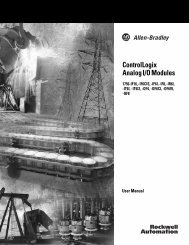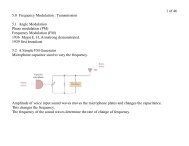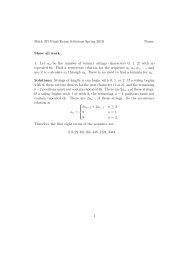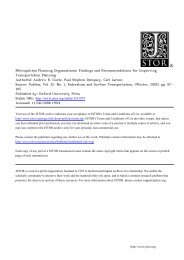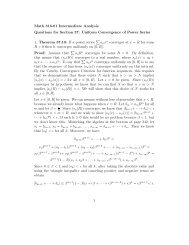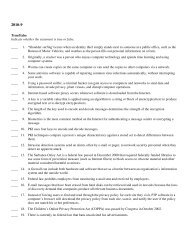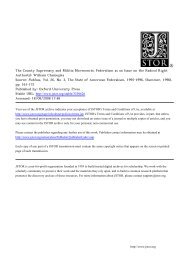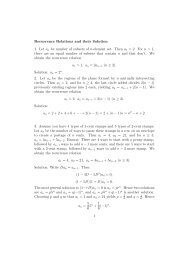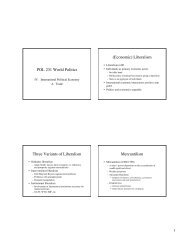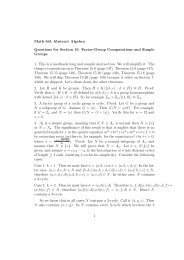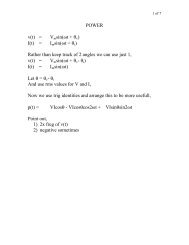Clemons and McBeth - MavDISK
Clemons and McBeth - MavDISK
Clemons and McBeth - MavDISK
Create successful ePaper yourself
Turn your PDF publications into a flip-book with our unique Google optimized e-Paper software.
46 PARTI . THEORY AND PRACTICE<br />
conversation! had two weeks before with Averell Harriman. . . sadly, neither of us forced a de-<br />
bate within the administration on that fundamental issue, <strong>and</strong> no such proposal was presented<br />
to Hanoi. (p. 300)<br />
Johnson was asking the right questions. But in his poker-playing fashion, he had held<br />
back crucial knowledge the Wise Men needed to give fully informed answerS. . . they had.re-<br />
ceived no Written materials. . . they did not receive Rear Admiral LaRocque's devastating re-<br />
port that a military victory in Vietnam was highly unlikely. Nor did they see Dick Helms's<br />
analysis that the risks of U.S. engagement were limited <strong>and</strong> controllable. And. to my<br />
disappointment, the president did not disclose to them a memor<strong>and</strong>um lhad given him the day<br />
before. (p. 306)<br />
A major cause of the debacle there lay in our failure to establish an organization of top<br />
civilian <strong>and</strong> military officials capable of directing the task. Over <strong>and</strong> over again, as my story<br />
of the decision.making process makes shockingly clear, we failed to address fundamental is-<br />
sues; our failure to identify them was not recognized; <strong>and</strong> deep-seated disagreements among<br />
the president's advisers about how to proceed were neither surfaced nor resolved.<br />
As I have suggested, this resulted in part from our failure to organize properly. No senior<br />
person in Washington dealt solely with Vietnam. With the president, the secretaries of state <strong>and</strong><br />
defense, the national security adviser, the chairman of the Joint Chiefs, <strong>and</strong> their associates di-<br />
viding their attention over a host of complex <strong>and</strong> dem<strong>and</strong>ing issnes,. some. of our shortcomings--<br />
in particular, our failure to debate systematically the most fundamental issues-could have been<br />
predicted. (p. 332)<br />
Source: Robert S. McNamara, In Retrospect: The Tragedy <strong>and</strong> Lessons of Vietnam. Copyright @}995<br />
by Robert S. McNamara. Used by pennission of Times Books, a Division of R<strong>and</strong>om House, Inc.<br />
Rationality or Something Else?<br />
We repeat our questions. Was the U.S. pursuit of the Vietnam War hurt by, or would it perhaps<br />
have been helped by, the use of the rational model? Is it accurate to characterize decision making<br />
at the highest levels of government during the Vietnam War as following the rational<br />
model, or is it more accurate to claim that it was not used?<br />
The story of decision making told by Robert McNamara reminds us not of the rational<br />
model. but of the model of decision making best described in Richard Neustadt <strong>and</strong> Ernest<br />
May's 1986 book, Thinking in Time. Neustadt <strong>and</strong> May argue that policymaking is predominantly<br />
marked by the following characteristics, which are antithetical to the rational model:<br />
I. Actors plunging toward action.<br />
2. Decision making heavily based upon "fuzzy analogies."<br />
3. The issue's past given inadequate attention.<br />
4. Key presumptions not reexamined, or (sometimes) even examined.<br />
S. People <strong>and</strong> organizations seen through the lenses of "stereotyped suppositions."<br />
6. "Little or no effort" made to consider choices in the light of an "historical sequence."<br />
(pp.31-33)<br />
This sort of decision making-what one might call the all-too-human model, not the ra-<br />
tional model-is what was exemplified by McNamara's history lesson. The common critique<br />
is t1awed. There is plenty to fault with the decision-making process during the Vietnam era,<br />
but upon examination we do not believe it can credibly be used to discredit the results derived<br />
from using the rational model. Interestingly, the decisions sUITounding the Iraq war have been at-<br />
tacked as flawed due to a perceived lack of rationality. The President, or his "neocon" advisors,<br />
I<br />
t<br />
,<br />
I<br />
,<br />
t<br />
II<br />
I<br />
I<br />
I<br />
1<br />
CHAPTER 2 . THE<br />
RATIONAL PUBUC POUCY METHOD 47<br />
are attacked for ab<strong>and</strong>oning realism in favor of a Wilsonian foreign policy; for ignoring intelligence<br />
that did not fit their world view; for being unreasoning, unbending, <strong>and</strong> iITational.<br />
Could rational decision making have prevented, or improved the results from, the war in Iraq?<br />
Obviously even the question, let alone the answers, are subjective <strong>and</strong> value driven. In 2007<br />
we learned that analyses predicted an insurgency <strong>and</strong> a long <strong>and</strong> bloody occupation that could<br />
fuel teITorism. Yet, the Bush administration (publicly at least) argued in 2003 that American<br />
involvement would be only a matter of months.<br />
As the examples of Vietnam <strong>and</strong> Iraq suggest, policy advice should not be tainted by<br />
political ideology. One of the major elements of the rational model is neutrality. While we<br />
do not necessarily believe that somebody can be totally neutral, we do believe that it is important<br />
that as an analyst you try to distance yourself from issues, <strong>and</strong> realize you own biases.<br />
Do not look at data <strong>and</strong> cherry-pick facts that meet your policy preferences.<br />
Oftentimes, your job will actually require you to try to keep your opinions <strong>and</strong> preferences<br />
out of your reports.<br />
But the core questions raised by the critics remain. Can rational decision making occur, <strong>and</strong><br />
if it can, would it help? Does the rational model offer any help in deciding public problems? The<br />
mini-case that follows illustrates the potential usefulness of the rational model in practice.<br />
The community of Portersville (a fictional name) is located in a rural area in an under-<br />
.populated state <strong>and</strong> has a population of 500. The nearest cornmunity (population 3.500)<br />
is located 60 miles away. Portersville had a.small health care clinic that was located in a decaying<br />
old drug store on the community's only paved street. In the fall of 1993, the city's<br />
buildil1ginspector closed the clinic after several bricks fell off the building's facade <strong>and</strong> onto<br />
theside-walk.In addition, the building's roof was in disrepair <strong>and</strong> near collapse.<br />
The health care.clinic provided primary care to the citizens of Portersville, <strong>and</strong> withollt<br />
it citizens would have to travel 60 miles for basic immunizations, ankle sprains, flu<br />
sYmptoms, <strong>and</strong> so forth. The city decided to pursue the building of a new health care<br />
clinic. The decision-making process illustrated the usefulness of the rational model.<br />
The community had received a grant for $10,000 to hire an urban architect to design<br />
a bll;ilding for the clinic. The architect, unaware of rural realities, designed a spacious<br />
4,100"square.foot building complete with the latest medical technology <strong>and</strong> a helicopter<br />
pad. The design stilTed interest among the community's health care specialists <strong>and</strong> among<br />
some citizens. The problem was that the architectural design was made without any analysis.<br />
Word of the multi-million-dollar design quickly spread throughout the community.<br />
The word around town was that the city leaders were trying to get the community to support<br />
a multi-million-donar<br />
could support.<br />
clinic that neither the community's tax base nor patient base<br />
City leaders feared the project was doomed. An outside university planner then entered<br />
the picture <strong>and</strong> took the community through a rational planning process. First. a mail<br />
sllrvey was sent to all residents, asking if they would support a new clinic, <strong>and</strong>, if so, under<br />
what circumstances. Second, focus groups were conducted at a town meeting one<br />
month after the survey mailing. From these two events, a problem was neatly defined,<br />
(continued)





